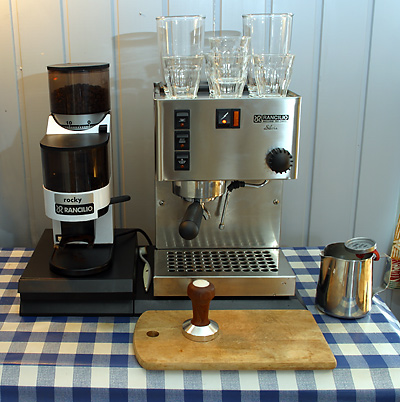|

Now for the shot. I used Crescendo beans from Mocca Kaffebrenneri
in Oslo, roasted five days before this shot, and ground
not too fine.
The basket was filled to the limit and levelled out with
the finger, then tamped with about 15-20kg pressure.
This is about 7-8 second into the shot. It's not 100% perfect,
as the left side poors slightly thicker than the right.
|

A few seconds later, it's pure honey.
|
|
 |
|
Morning
coffee at Dante Espressobar(our kitchen), Porsgrunn,
Norway
|
The shot was above average for me, but (probably) not a
God Shot, and I skipped the temperature control technique
discussed on alt.coffee. It proves the capability of the
Silvia and Rocky, and the Crescendo coffee (I get the same
result from the Ottolina Fortissima, which also tastes similar).
Also, since I'm a beginner with only a few months of practice,
in my humble opinion it proves that making good espresso
is not art, but rather craftmanship. The art lies in the
presentation, I guess, and I'm absolutely no good in that
regard. It's not really important to me either.
If what you've seen ignites a dormant interest, follow
the links below for more, and better, information about
making espresso and choosing the right equipment:
http://www.coffeegeek.com
- An excellent place to begin. Both short and in depth information
about the espresso history, process, techniques, and equipment.
Espresso!
My espresso - An ongoing series of articles from an
afficcionado
Schomer's
articles - A guru in espresso shares his wisdom
Temperato - Norwegian
dealer of high quality espresso machines and the excellent
Ottolina Coffee
Newsgroups to visit are alt.coffee, and for Norwegians
no.alt.mat.drikke
When scanning through the pages above, you'll get lost
from time to time in all the information available and in
all the different, and sometimes contradictory, theories
and practises that are discussed. You'll probably believe
at some point that it's too difficult to make good espresso.
Don't loose faith and remember that the process is not an
art, it's a craft you can learn within months. I mean, I
did - although I have a long way to go!
Enjoy!
Porsgrunn, 28th January 2002
A year later, more or less
We've stuck to the Ottolina coffee from Temperato, which
has proven to be excellent, and every batch is equally good
in quality. From time to time we've used the Malabar as
well, but unfortunately the age of the beans vary a lot.
If the bean is oily it's old, don't buy it, is a lesson
learned.
Steaming to perfection
Learning to make Latte Art takes patience, and after one
year with the Silvia, I'm still no maestro. Not surprising
though, with all the parameters in the process, you can
spend years perfecting your skills. But it's fun and I'm
improving. I also learned a technice which helps me steam
the milk for two cortados (2,5-3 dl) with success almost
every time;
Use cold milk straight from the fridge.
After you've switched on the steam button(right after you
pulled the shot), let it heat up all the way until the thermostat
turns off the heater (about 1,5 to 2 minutes - with practise you will get a feeling for how to start steaming just before it turns off and hence keep even high pressure throughout - but this is in my opinion not as essential as some claim). Immediately
empty the wand for water, stick it shallow into the milk (but deep enough to avoid too much air being sucked in with large bubbles as a result) and
open the valve almost all the way. After 10-20 seconds open it up all the way and stick the wand deeper. Keep the wand away from the mug to avoid burning the milk and keep it in an angle so that the milk rotates nicely. The steamer will microfroth your milk in no
time, well before the pressure sinks to where the heater
is turned on again. The latter will happen around 60ºC.
Stop steaming when the temp is around 65-70ºC.

An early morning
cortado. You cannot have a better start....
Steaming bigger volumes
If you need to steam more milk than the above
example, you should try to get going just before the thermostat
turns off the heater. This way the heater will stay on and
keep the pressure high throughout the steam process. The
reason I choose to let it turn off when steaming for cortados,
is because then I know exactly how much pressure is on,
and that it's sufficient for the amount of milk. The time
for the pressure to build vary slightly, which makes it
a bit more of a gamble if you try to start steaming before
the heater has turned off. Since I started to let it turn
off, the success factor has gone up to near 100%.
Porsgrunn Oktober 2002
Dag

|


 The
Rancilio Rocky coffee grinder to the left, the Rancilio
Silvia espresso machine to the right, both resting on a
base which includes a knock box for knocking out the coffee
puck.
The
Rancilio Rocky coffee grinder to the left, the Rancilio
Silvia espresso machine to the right, both resting on a
base which includes a knock box for knocking out the coffee
puck. 







